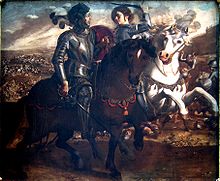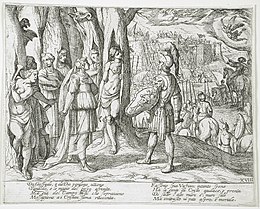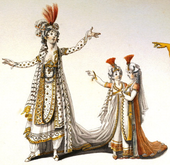Jerusalem Liberated (Epic)
The liberated Jerusalem ( Italian : La Gerusalemme liberata ) is an epic by Torquato Tasso .
Origin of the work
Tasso worked on his main work for over 15 years, which he completed in April 1574 . The following summer he read it to Duke Alfonso II d'Este and the princesses. The most pleasant time of his life was over, his best works were already written; suddenly he was faced with unexpected problems. Instead of trusting his instincts and releasing the work, he felt insecure.
He sent manuscripts of the Gerusalemme to various sizes of his time - writers, theologians, philosophers - to obtain their opinions. He asked them to express their criticism and wanted to include their suggestions in his work, insofar as they coincided with his ideas. In May Tasso went to Padua and Vicenza and asked the great scholar Gian Vincenzo Pinelli to examine the work. In September 1575 he went to Rome , where he presented his work to Scipio Gonzago , Flaminio de 'Nobili , Silvio Antoniano , Pier Angelis Bargeo , Sperone Speroni , and in Florence to the famous writer Vincenzo Borghini .

The result: each of these sincere friends praised the work in general, but wanted to work on details: the plot, the title, individual episodes, the choice of words or the basic moral tone. One wanted it to be more regular, more classic, another wanted a more romantic tone; a friend remarked that the Inquisition would not tolerate the supernatural parts of the work, another wanted the most enchanted passages, the love stories of Armida, Clorinda and Erminia, to be expanded. So Tasso had to defend himself against all these objections. Time has shown that Tasso's self-chosen critics were not suited to properly assess the work. They felt that the epic form chosen by Tasso did not fit the romantic content of the poem. So they advised Tasso not to do the right thing, to publish the work, but to revise it.
Tasso, already overly challenged by his studies, the strenuous life at court and his work as a man of letters, could no longer cope with this additional effort. His health began to suffer: he complained of headaches, suffered from malaria-like chills and wished to leave Ferrara . So he began negotiating with the court of Florence, which angered the Duke of Ferrara, who hated nothing so much as when a courtier abandoned him for a rival duke. He suspected that if he let Tasso go the Gerusalemme would be dedicated to Tasso's new masters, the Medici , and consequently refused Tasso permission to leave the court.
Content of the work

The work describes the initial disagreement and setbacks of Christians in the conquest of Jerusalem and their eventual success.
At the beginning of the work Sofronia , a Christian virgin from Jerusalem, accuses herself of a crime before the Muslim ruler of Jerusalem in order to prevent a general massacre of the Christian minority in Jerusalem. Her lover Olindo tries to save her and therefore also accuses herself of a crime before the Islamic ruler.
Clorinda , a virgin warrior, joins the Muslims in Jerusalem. The Christian King Tankred falls in love with her. During a nighttime battle in which Clorinda sets a Christian siege tower on fire, she is accidentally killed by Tankred. Before she dies, she converts to Christianity and is baptized by Tankred. (The character of Clorinda is inspired by Virgil's character Camilla and by Ariost's Bradamante from Orlando furioso .) The circumstances of Clorinda's birth, who was born as Albina to Ethiopian parents, are modeled on motifs from the novel Aithiopika by Heliodorus of Emesa .

Erminia (in German translations often "Hermine"), a virgin from Antioch , falls in love with Tankred and begs the people of Jerusalem to help him. But when she discovers that Tankred loves Clorinda, she becomes jealous. One night she steals Clorinda's armor and leaves Jerusalem to look for Tankred. But she is attacked by Christian soldiers, who mistake her for Clorinda, and so she flees to a nearby forest. There she is looked after by a shepherd family. In the further course of the work she appears accompanied by followers of the sorceress Armida , but eventually she leaves the Muslim population and changes to the Christian side. When Tankred is badly wounded in battle, she heals him.
The Saracen sorceress Armida ( modeled after Homer's sorceress Circe and the sorceress Alcina in Ariost's Orlando furioso ) appears in the Christian camp and asks about their destination; their speeches lead to a dispute among the Christian knights. Some of the knights leave the camp with her and are shortly thereafter transformed into animals by the sorceress. Armida then tries to kill the famous Christian crusader Rinaldo (his name also appears in Ariostos Orlando furioso ); but she falls in love with him and takes him to a magical island. Two Christian knights search for Rinaldo and discover the magical fortress of the sorceress. They manage to get to Rinaldo and they give him a mirror made of diamonds. When Rinaldo looks in the mirror, he recognizes the enchanted world around him and leaves the magic island to continue fighting in front of Jerusalem. Armida is left heartbroken. She tries to commit suicide, but Rinaldo finds her in time and prevents this. He persuades them to convert to Christianity.
Reception of the work
The work was very successful in Europe over the next two centuries. Various critics, however, condemned the work because of its magical extravagances and the confused narrative content of the work.
Works based on the epic

Music (selection)
- Giaches de Wert , La Gerusalemme liberata . Madrigals (around 1595)
- Pierre Guedron, Ballet de la Delivrance de Renaud (Paris, 1617)
- Claudio Monteverdi , Il combattimento di Tancredi e Clorinda (1624), printed in the eighth book of madrigals (1638)
- Biagio Marini , Le lagrime d'Erminia (Parma, after 1620)
- Girolamo Giacobbi , Il Tancredi (Bologna, before 1629)
- Michelangelo Rossi , Erminia sul Giordano (Rome, 1633)
- Benedetto Ferrari , Armida (Venice, 1639). Lost music
- Marco Marazzoli , Armida (Ferrara, 1641)
- Jean-Baptiste Lully , Armide (Paris, 1686)
- Carlo Pallavicino , La Gerusalemme liberata (Venice, 1687)
- Carlo Francesco Pollarolo , Gli avvenimenti di Erminia e di Clorinda (Venice, 1693). Lost music
- Teofilo Orgiani , Amori di Rinaldo con Armida (Brescia, 1697). Lost music
- André Campra , Tancrède (Paris, 1702)
- Philip II, Duke of Orléans , Suite d'Armide ou La Jérusalem délivrée (Fontainebleau, 1704)
- Giovanni Maria Ruggieri , Armida abbandonata (Venice, 1707)
- Giuseppe Boniventi , Armida al campo (Venice, 1708)
- Teofilo Orgiani , Armida regina di Damasco (Verona, 1711). Lost music
- Georg Friedrich Handel , Rinaldo (London, 1711)
- Giacomo Rampini , Armida in Damasco (Venice, 1711)
- Giuseppe Maria Buini , Armida abbandonata (Bologna, 1716)
- Antonio Vivaldi , Armida al campo d'Egitto (Venice, 1718)
- Giuseppe Maria Buini , Armida delusa (Venice, 1720)
- Henry Desmarest , Renaud, ou La Suite d'Armide (Paris, 1722)
- Georg Caspar Schürmann , Das conquered Jerusalem, or Armida and Rinaldo (Braunschweig, 1722)
- Giovanni Bononcini , Erminia (London, 1723)
- Antonio Bioni , Armida abbandonata (Prague, 1725)
- Antonio Bioni , Armida al campo (Breslau, 1726)
- Tomaso Albinoni , Il trionfo di Armida (Venice, 1726)
- Antonio Pollarolo , L'abbandono di Armida (Venice, 1729)
- Luca Antonio Predieri , Armida placata (Vienna, 1750)
- Giovanni Battista Mele , Armida placata (Madrid, 1750)
- Carl Heinrich Graun , Armida (Berlin, 1751)
- Francesco Geminiani , The Inchanted Forrest (London, 1754)
- Tommaso Traetta , Armida (Vienna, 1761)
- Niccolò Jommelli , Armida abbandonata (Naples, 1770)
- Antonio Salieri , Armida (Vienna, 1771)
- Christoph Willibald Gluck , Armide (Paris, 1777)
- Josef Mysliveček , Armida (Milan, 1780)
- Joseph Haydn , Armida (1784)
- Gioachino Rossini , Armida (Naples, 1817)
- Johannes Brahms Rinaldo (premiered 1869) cantata
- Antonín Dvořák Armida (1904)
- Judith Weir , Armida (2005)
- Lucia Ronchetti , Rival (Opera) (2017)
Plays
- Max Turiel, Clorinda Deleste, El Camino del Sol . Partly adapted from Gerusalemme Liberata , ISBN 84-934710-8-9 , Ediciones La Sirena 2006.
painting

More detailed information can be found as an appendix in: Max Wickert , The Liberation of Jerusalem (Oxford University Press, 2009)
- Domenico Tintoretto : Tancred baptizes Clorinda , 1586–1600, Museum of Fine Arts , Houston
- Guercino : Erminia finds the wounded Tancred , approx. 1618–19, Galleria Doria Pamphilj , Rome
- Domenichino : Erminia with the Shepherds , 1622–25, Louvre , Paris
- Anthonis van Dyck : Rinaldo and Armida , around 1629, Sanssouci Picture Gallery , Potsdam
- David Teniers : 12-part picture cycle on Rinaldo and Armida , 1628–1630 (?), Prado , Madrid
-
Nicolas Poussin :
- Tancred and Erminia , around 1630, Hermitage
- Tancred and Erminia , around 1630, Barber Institute of Fine Arts , Birmingham
- Paolo Finoglia : cycle of paintings with ten episodes from Gerusalemme Liberata , ca. 1634–43, Castello von Conversano
- Mattia Preti : Clorinda saves Olindo and Sophronia , 1646, Musei di Strada Nuova ( Palazzo Rosso ), Genoa
- Lorenzo Lippi : (1647/1650), Kunsthistorisches Museum , Gemäldegalerie, Vienna
- Pier Francesco Mola : Tancred is revived by Erminia and Vafrino , around 1650, Louvre , Paris
- Francesco Maffei : Rinaldo with the mirror shield , around 1650–55, Getty Center , Los Angeles
- Luca Giordano : Rinaldo and Armida , around 1672–74, Musée des Beaux-Arts , Lyon
- Gregorio Lazzarini : Rinaldo and Armida , around 1690, Slovenian National Gallery , Ljubljana
- François Boucher : Rinaldo and Armida , 1734, Louvre , Paris
-
Gian Battista Tiepolo :
- Rinaldo enchanted by Armida , 1742/45, Art Institute , Chicago
- Rinaldo leaves Armida , Villa Valmarana , Vicenza
- Giovanni Antonio Guardi : Erminia and Vafrino find the wounded Tancred , around 1750–55, Accademia , Venice
- Giovanni Antonio and Francesco Guardi : Erminia with the Shepherds , around 1750–55, National Gallery of Art , Washington
- Jean-Honoré Fragonard : Rinaldo in the Armida Gardens , 1763, Louvre , Paris
- Francesco Hayez : Rinaldo and Armida , 1812–13, Accademia, Venice
- Robert Seymour : Jerusalem Delivered , with over 100 figures, exhibited at the Royal Academy , London 1822
- Theodor Hildebrandt : Tancred and Clorinda (around 1830)
- Eugène Delacroix : Clorinda saves Olindo and Sophronia , 1856, Neue Pinakothek , Munich
Engravings, drawings, illustrations

- Agostino Carracci and Giacomo Franco: copper engravings after Bernardo Castello as an illustration of an edition of Tasso's La Gerusalemme liberata in Girolamo Bartoli, Genoa, 1590.
- Antonio Tempesta : Three series of 20 pictures each (drawings and engravings), partly as illustrations of editions of the Gerusalemme liberata (1607, around 1620, and the end of the 1620s), in various collections ( Gabinetto Nazionale della Grafica , Rome; State Collection of Graphic Art , Munich).
literature
- Gerusalemme liberata ed.Lanfranco Caretti (Einaudi, 1971) ISBN 978-88-06-17569-6
- Eckhard Leuschner: Antonio Tempesta's Drawings for a “Gerusalemme liberata” , in: Master Drawings , Vol. 37, No. 2, summer 1999, pp. 138-155
Web links
- Original text:
- Translations:
- Jerusalem Liberated in Fine Art (Italian)
Individual evidence
- ↑ David Teniers' cycle of pictures about Rinaldo and Armida on the Prado website (accessed May 11, 2020)
- ↑ Eckhard Leuschner: Antonio Tempesta's Drawings for a "Gerusalemme liberata" , in: Master Drawings , Vol. 37, No. 2, Sommer 1999, pp. 138–155, here: pp. 139 f
- ↑ Eckhard Leuschner: Antonio Tempesta's Drawings for a "Gerusalemme liberata" , in: Master Drawings , Vol. 37, No. 2, summer 1999, pp. 138-155








